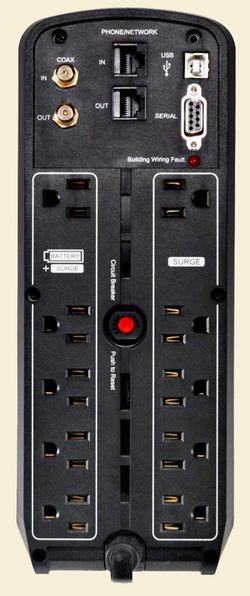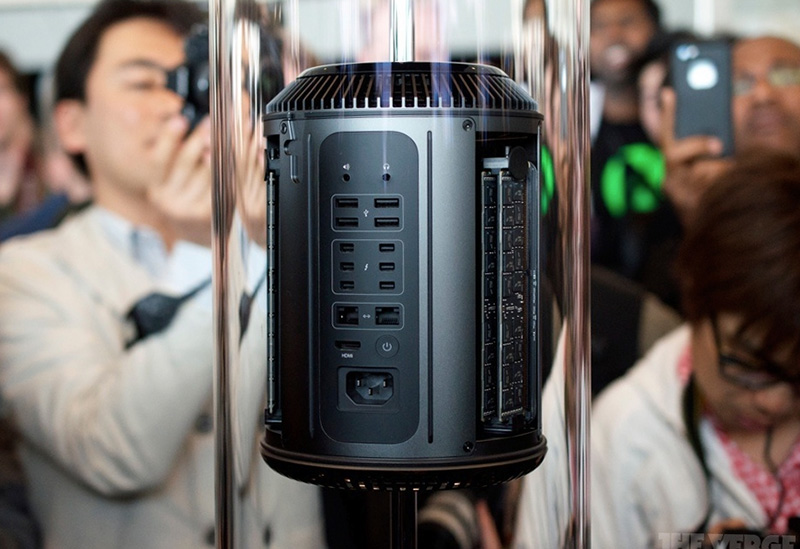This week's column by Ctein
I don't mean the package delivery service, although I always look forward to the appearance of the big brown boxy truck on my block. UPS stands for Uninterruptible Power Supply, and if you're at all dependent upon your computer(s) it's cheap insurance and peace of mind.
A UPS is a box about the size of a shoebox (more or less) that plugs into the wall socket and has a bunch of power outlet sockets on the back that your electronics plug into. Inside the UPS is a sealed lead acid battery, some AC/DC converters, and monitoring circuitry. If the line frequency or voltage fluctuates (or goes out entirely), the UPS switches to its internal battery within a cycle and continues to feed 120V AC to its outlet sockets.
Depending on how heavily you've loaded down the supply, the internal battery will be good for anywhere from about a half dozen minutes to half an hour or more. That's enough time for you to save any work you're in the middle of and shut down any electronics.
It'll not only save you from lost work product, but it can save you from lost equipment. Four or so years back we had a power brownout here that somehow managed to fry my Apple Cinema Display, despite there being a transformer between the display and the wall socket. Probably should've gotten a UPS back then, but I didn't. The local power's been reliable for the past 15 years, with outages a rare thing.
Two weeks ago was the exception. Four outages in three days, and I thought I was going to go nuts. It was a Murphy's-law situation. I was doing some orbital simulations for a book project (a story I may tell you at some future time but not now). It was straightforward but somewhat tedious, repetitive work. The software that does this well only runs under Windows, so I was running my Windows virtual environment on the iMac.
There's no difference between running virtual Windows and real Windows...except...if you yank the plug on virtual Windows, it leaves the virtual hard drive file in a confused state. Confused, as in unbootable and unusable. The only recovery is to go to the backup and restore the virtual drive file.
That's fine, except 1.) it takes a fair chunk of time to port over that large a file from the backup drive and 2. any work done after the last backup is gone. Doesn't matter whether it was saved or not; it got saved to a virtual drive that no longer exists.
After the first outage, it took me most of the day to figure all this out and get it straightened out and back to where I'd been.
The second time it happened, I only lost about half a day's productivity.
After that, I got completely paranoid and started archiving what I was doing every half-hour. Which was another source of wasted time and still didn't eliminate the time it took to restore from the backup.
Let me repeat: this was somewhat tedious, repetitive work I was doing. Oh yeah, how much more fun it was having to do it repeatedly!
 Enough was enough. I logged into TOP's Amazon affiliate link and bought a CyberPower CP1350PFCLCD PFC Sinewave UPS 1350VA 810W PFC Comaptible Mini-Tower
Enough was enough. I logged into TOP's Amazon affiliate link and bought a CyberPower CP1350PFCLCD PFC Sinewave UPS 1350VA 810W PFC Comaptible Mini-Tower for $159.99. It was possibly more capacity than I needed, but more is better and it wasn't much more expensive than a lower capacity unit.
-
Left: rear panel of the
CyberPower tower
-
It's a nice design: made to be energy-efficient (it "sleeps" itself except when it needs to top off the battery or detects a line fluctuation) and it puts out sine wave power instead of square wave (supercheap UPS's do the latter, and that may not matter with modern transformers/switching supplies, but then again...). The front panel display is great and tells me just what I need to know about the state of my power.
With a couple of power strips plugged into the UPS, I had it supporting both the 27" iMac and the 15" MacBook Pro, the Apple Cinema Display, all eight external hard drives, the phone service/Internet router/modem, my AudioEngine computer speakers that Mike recommended, even the 60W desk lamp that happened to be plugged into one of the power strips. With everything turned on, the UPS reported that I was drawing less than half its capacity and that I had 10 minutes to shut things down in the event of a power failure.
Naturally, the next thing I did was to yank the power cord from the wall socket. The office electronics didn't blink. After I turned off the desk lamp and the two computers, the UPS's display informed me that I had well over an hour of runtime remaining before the battery would be drained.
There are two reasons why that might matter. The first is that my MacBook Pro runs fine off its batteries, so the UPS could give me more than an hour's access to its external drives. Nice, if I don't want my work interrupted quite so abruptly. The second is just a maybe—I won't know what will actually happen until I have a real power failure. Our access to the world is through a fiber-optic phone/data line; we no longer have a copper wire phone line. That means that in the case of loss of house power, the phones go down along with the inter-webs. If all it takes to keep those up and running is to keep the router/modem live, then the UPS will do the job (for a while). Dunno if that's the case, but I'm hopeful.
I'm almost looking forward to the next power outage to test all of this out for real.
Well, no, not really.
Ctein
Columnist Ctein looks out for your supply of power every week on Wednesdays.
©2013 by Ctein, all rights reserved
Links in this post may be to our affiliates; sales through affiliate links may benefit this site.
(To see all the comments, click on the "Comments" link below.)
Featured Comments from:
Dave (a.k.a. Sparky) in NM: "Our power comes from a rural electric co-op, and outages are regular occurrence. For that reason, we've got four UPS devices feeding all our computer equipment. They've been invaluable. Not only have they provided us with consistent power and surge protection, but on three occasions they sacrificed themselves, saving our equipment from lightning strikes. Unfortunately, many of the other electronics in the house and office that were only connected to surge protectors were fried. I've yet yet to find a practical method of protecting network cabling from transferring lightning strikes to connected equipment. None of our strikes were direct hits, but they were close enough to find their way through in-wall CAT-5e cabling and blow out routers and gigabit switches. If you've got any suggestions aside from abandoning the wired portions of my network and switching to completely to wireless, I'd love to hear them...."
M. Stanton: "I wonder how long that UPS would run my Gralab timer and the 211 bulb in my D5XL?"
Ctein replies: Hmmm, well, I can't imagine the whole assemblage is drawing over 200 watts, and this particular model is rated at 800 watts with a 100 watt-hour battery...so even allowing for a 50% safety margin, you'd have a good 15 minutes run time. Which ought to be enough to complete a print exposure or several.
I've been working in the darkroom when the power went off. It's kinda annoying, ain't it? And, somehow, the dark gets even darker.
Will Frostmill replies to Dave (a.k.a. Sparky) in NM: "I can offer some suggestions regarding Cat-5 protection.
"In general, you want the ground each device sees at a given point to be the same. You could use a power strip that has a dumb ethernet passthrough, which grounds the Cat-5 at precisely the same point as the equipment it is connected to. This lets any surge "see" the same ground value at any given group of equipment. Lightning can do math: if the AC power line drifts high by 1500 millivolts, but the Cat-5 only rises 800, then 700 millivolts are going to subtract themselves through your computer in an effort to reach that ethernet port. (Make sure your three-prong grounded wall outlets are actually grounded. There's a cheap tester for that.) You would need to do this at every single point you connect something to a Cat-5 jack, and you would need to do this for all the other cabling as well: telephone lines and cable TV lines as well.
"Prudence dictates the same kind of common ground setup back at the router and modem. I'll make a wild guess that this would make the biggest difference.
"Take a peek at the standard grounding diagrams that now are printed at the front of nearly every home electronics user manual. You should see something similar at your home, with TV antennas, cable TV, and electrical power all having ground lines that are bonded at the same point at the Demarc, the point at which they enter your home.
"If this doesn't look right, please hire an electrician to correct it for you. DO NOT TOUCH IT. The ground stake or post MAY HAVE LIVE POWER FLOWING THROUGH IT. It's supposed to do this as a safety measure when things go wrong. Most of those things trip breakers, so no problem, but in the rare exceptional case YOU COULD DIE if you don't know how to properly check it.
There are some fantastic resources out there on the net if you start googling for terms like 'lighting protection,' 'spark arrestors,' 'RF ground,' or 'HAM radio ground.' Polyphaser has some nice technical bulletins.
"Here is a company that sells Cat-5 lightning protectors at 28–35$ a pop.
"I'm not endorsing either company, by the way."
























